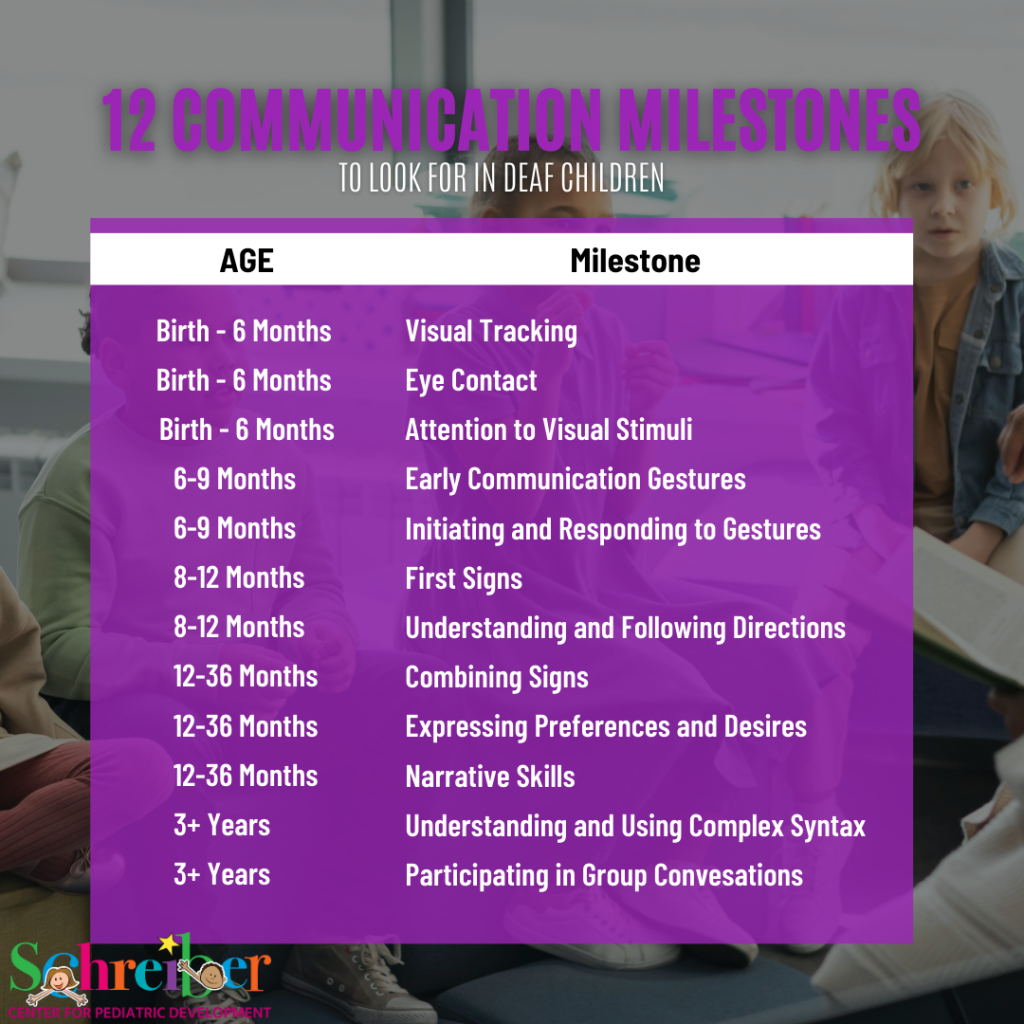12 Communication Milestones to Look for in Deaf Children
September 19, 2023When it comes to the developmental journey of babies and children who are deaf, American Sign Language (ASL) communication milestones play an important role. Knowing what unique milestones to look for in babies, toddlers, and children who are deaf, allows caregivers to better understand the progression of communication skills. This article outlines 12 communication milestones caregivers of deaf children should look for to help guide their children on their unique communication journey through ASL.
Birth-6 Months: Building the Visual Foundation
1. Visual Tracking: From birth to six months, babies who are deaf begin to visually track moving objects and people. This foundational skill paves the way for their engagement in sign language communication.
2. Eye Contact: Establishing eye contact with caregivers and responding to visual cues is crucial for effective communication in ASL. Babies who are deaf develop this ability, enabling meaningful interactions.
3. Attention to Visual Stimuli: Infants who are deaf often display heightened attentiveness to colorful objects and gestures. This is because they rely on their sense of sight for communication input.
6-9 Months: Early Gestures and Interaction
4. Early Communication Gestures: Deaf babies might initiate simple gestures like waving “bye-bye” or raising their arms to be picked up. They could also display signs of wanting more, pointing at objects, or imitating gestures.
5. Initiating and Responding to Gestures: Babies who are deaf begin building the foundation for back-and-forth communication by both initiating their gestures to express needs or interests and responding to gestures from caregivers.
8-12 Months: Transition to First Signs
6. First Signs: The transition from gestures to recognizable signs like “milk,” “eat,” or “mom” starts around 8-12 months old. These initial signs become the building blocks for more intricate communication.
7. Understanding and Following Directions: Deaf babies gradually grasp the ability to comprehend and follow simple sign language directions like “come here” or “give me.”
12-36 Months: Forming Complex Communication
8. Combining Signs: Toddlers who are deaf begin combining signs to form two-word phrases between 1 and 3 years old. This progression allows them to express more complex thoughts and desires.
9. Expressing Preferences and Desires: As toddlers learn more ASL, they use signs to voice preferences, wants, and dislikes. This allows them to increase their ability to actively engage in conversations.
10. Narrative Skills: As they progress and broaden their signing vocabulary children who are deaf are able to convey simple stories and describe events using ASL, nurturing their narrative skills.
3+ Years: Maturing Communication Abilities
11. Understanding and Using Complex Syntax: As children who are deaf grow, their ASL skills evolve to include more complex sentence structures and grammatical features, enhancing their overall communication abilities.
12. Participating in Group Conversations: Proficiency in group conversations, topic tracking, and turn-taking is a significant milestone for children who are deaf using ASL. This skill underscores their ability to engage actively in social settings.
Remember that every child follows their own developmental path. Early exposure to ASL, consistent interaction, and access to a supportive environment are all important to helping babies, toddlers, and children who are deaf develop ASL skills. Celebrating these communication milestones helps to foster a culture of inclusivity, understanding, and effective communication for all.
If you child is Deaf and you are interested in learning more about how Schreiber’s Pediatric Therapies can help your child visit: http://www.schreiberpediatric.org/therapy-services/
As a nationally recognized pediatric facility, the Schreiber Center for Pediatric Development provides family-centered education and therapy programs for infants, children and adolescents with disabilities, developmental delays, and acquired injuries. Our goal-oriented approach maximizes each child’s ability to function independently within the community.
